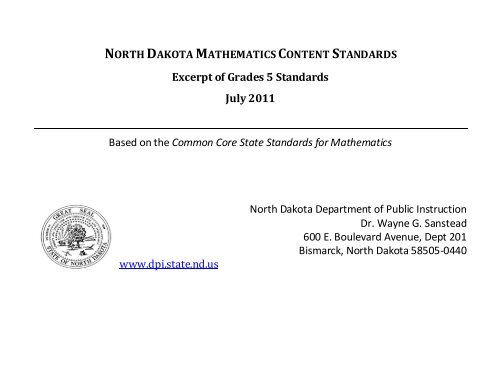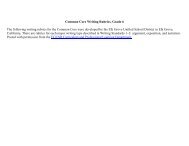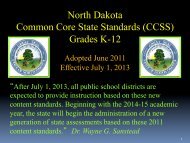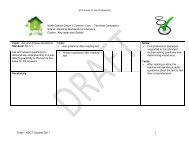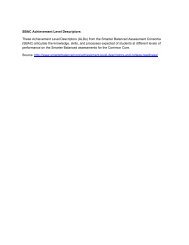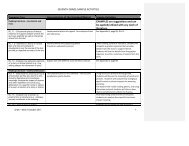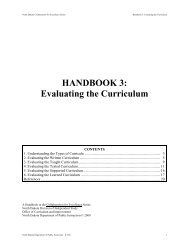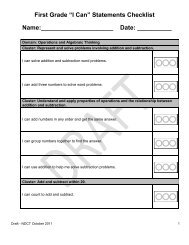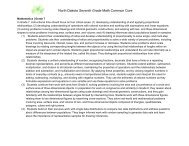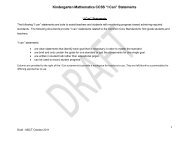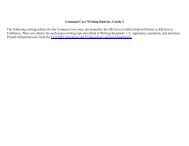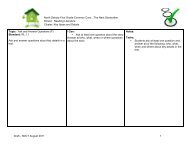A. ND Mathematics Content Standards, Grade 5 - ND Curriculum ...
A. ND Mathematics Content Standards, Grade 5 - ND Curriculum ...
A. ND Mathematics Content Standards, Grade 5 - ND Curriculum ...
You also want an ePaper? Increase the reach of your titles
YUMPU automatically turns print PDFs into web optimized ePapers that Google loves.
NORTH DAKOTA MATHEMATICS CONTENT STA<strong>ND</strong>ARDS<br />
Excerpt of <strong>Grade</strong>s 5 <strong>Standards</strong><br />
July 2011<br />
Based on the Common Core State <strong>Standards</strong> for <strong>Mathematics</strong><br />
www.dpi.state.nd.us<br />
North Dakota Department of Public Instruction<br />
Dr. Wayne G. Sanstead<br />
600 E. Boulevard Avenue, Dept 201<br />
Bismarck, North Dakota 58505-0440
Introduction<br />
Toward greater focus and coherence<br />
<strong>Mathematics</strong> experiences in early childhood settings should concentrate on (1) number (which includes whole number, operations , and relations) and (2)<br />
geometry, spatial relations, and measurement, with more mathematics learning time devoted to number than to other topics. Mathematical process goals<br />
should be integrated in these content areas.<br />
—National Research Council, 2009<br />
The composite standards [of Hong Kong, Korea and Singapore] have a number of features that can inform an international benchmarking process for the<br />
development of K–6 mathematics standards in the U.S. First, the composite standards concentrate the early learning of mathematics on the number,<br />
measurement, and geometry strands with less emphasis on data analysis and little exposure to algebra. The Hong Kong standards for grades 1–3 devote<br />
approximately half the targeted time to numbers and almost all the time remaining to geometry and measurement.<br />
— Ginsburg, Leinwand and Decker, 2009<br />
Because the mathematics concepts in [U.S.] textbooks are often weak, the presentation becomes more mechanical than is ideal. We looked at both<br />
traditional and non-traditional textbooks used in the US and found this conceptual weakness in both.<br />
— Ginsburg et al., 2005<br />
There are many ways to organize curricula. The challenge, now rarely met, is to avoid those that distort mathematics and turn off students.<br />
— Steen, 2007<br />
For over a decade, research studies of mathematics education in high-performing countries have pointed to the conclusion that the mathematics<br />
curriculum in the United States must become substantially more focused and coherent in order to improve mathematics achievement in this country. To<br />
deliver on the promise of common standards, the standards must address the problem of a curriculum that is “a mile wide and an inch deep.” These<br />
<strong>Standards</strong> are a substantial answer to that challenge.<br />
It is important to recognize that “fewer standards” are no substitute for focused standards. Achieving “fewer standards” would be easy to do by resorting to<br />
broad, general statements. Instead, these <strong>Standards</strong> aim for clarity and specificity.<br />
Assessing the coherence of a set of standards is more difficult than assessing their focus. William Schmidt and Richard Houang (2002) have said that<br />
content standards and curricula are coherent if they are:<br />
articulated over time as a sequence of topics and performances that are logical and reflect, where appropriate, the sequential or<br />
hierarchical nature of the disciplinary content from which the subject matter derives. That is, what and how students are taught<br />
should reflect not only the topics that fall within a certain academic discipline, but also the key ideas that determine how knowledge<br />
North Dakota <strong>Mathematics</strong> <strong>Content</strong> <strong>Standards</strong><br />
Based on the Common Core State <strong>Standards</strong><br />
Introduction 1 June 2011
is organized and generated within that discipline. This implies that to be coherent, a set of content standards must evolve f rom<br />
particulars (e.g., the meaning and operations of whole numbers, including simple math facts and routine computational procedures<br />
associated with whole numbers and fractions) to deeper structures inherent in the discipline. These deeper structures then serve as<br />
a means for connecting the particulars (such as an understanding of the rational number system and its properties). (emphasis<br />
added)<br />
These <strong>Standards</strong> endeavor to follow such a design, not only by stressing conceptual understanding of key ideas, but also by continually returning to<br />
organizing principles such as place value or the properties of operations to structure those ideas.<br />
In addition, the “sequence of topics and performances” that is outlined in a body of mathematics standards must also respect what is known about how<br />
students learn. As Confrey (2007) points out, developing “sequenced obstacles and challenges for students…absent the insights about meaning that<br />
derive from careful study of learning, would be unfortunate and unwise.” In recognition of this, the development of these <strong>Standards</strong> began with researchbased<br />
learning progressions detailing what is known today about how students’ mathematical knowledge, skill, and understanding develop over time.<br />
Understanding mathematics<br />
These <strong>Standards</strong> define what students should understand and be able to do in their study of mathematics. Asking a student to understand something<br />
means asking a teacher to assess whether the student has understood it. But what does mathematical understanding look like One hallmark of<br />
mathematical understanding is the ability to justify, in a way appropriate to the student’s mathematical maturity, why a particular mathematical statement is<br />
true or where a mathematical rule comes from. There is a world of difference between a student who can summon a mnemonic device to expand a<br />
product such as (a + b)(x + y) and a student who can explain where the mnemonic comes from. The student who can explain the rule understands the<br />
mathematics, and may have a better chance to succeed at a less familiar task such as expanding (a + b + c)(x + y). Mathematical understanding and<br />
procedural skill are equally important, and both are assessable using mathematical tasks of sufficient richness.<br />
The <strong>Standards</strong> set grade-specific standards but do not define the intervention methods or materials necessary to support students who are well below or<br />
well above grade-level expectations. It is also beyond the scope of the <strong>Standards</strong> to define the full range of supports appropriate for English language<br />
learners and for students with special needs. At the same time, all students must have the opportunity to learn and meet the same high standards if they<br />
are to access the knowledge and skills necessary in their post-school lives. The <strong>Standards</strong> should be read as allowing for the widest possible range of<br />
students to participate fully from the outset, along with appropriate accommodations to ensure maximum participation of students with special education<br />
needs. For example, for students with disabilities reading should allow for use of Braille, screen reader technology, or other assistive devices, while writing<br />
should include the use of a scribe, computer, or speech-to-text technology. In a similar vein, speaking and listening should be interpreted broadly to<br />
include sign language. No set of grade-specific standards can fully reflect the great variety in abilities, needs, learning rates, and achievement levels of<br />
students in any given classroom. However, the <strong>Standards</strong> do provide clear signposts along the way to the goal of college and c areer readiness for all<br />
students.<br />
North Dakota <strong>Mathematics</strong> <strong>Content</strong> <strong>Standards</strong><br />
Based on the Common Core State <strong>Standards</strong><br />
Introduction 2 June 2011
How to read the grade level standards<br />
<strong>Standards</strong> define what students should understand and be able to do.<br />
Clusters are groups of related standards. Note that standards from different clusters may sometimes be closely related, because mathematics is a<br />
connected subject.<br />
Domains are larger groups of related standards. <strong>Standards</strong> from different domains may sometimes be closely related.<br />
Cluster<br />
Domain<br />
Code (grade, domain, standard)<br />
Standard<br />
Domain: Counting and Cardinality<br />
Cluster: Know number names and the count main sequence.<br />
main<br />
Code Standard Annotation<br />
K.CC.1 Count to 100 by ones and by tens. Pennies and dimes may be used to model ones and tens (<strong>ND</strong>)<br />
K.CC.2<br />
K.CC.3<br />
Count forward beginning from a given number within the known sequence (instead<br />
of having to begin at 1).<br />
Write numbers from 0 to 20. Represent a number of objects with a written numeral<br />
0-20 (with 0 representing a count of no objects).<br />
Number range for this skill should be up to 100. (CCSS)<br />
Example: Student is given a number within the range of 0 to 100. For example,<br />
use 56. Student must count forward in sequence from that number. “56, 57, 58,<br />
59” on so on. (<strong>ND</strong>)<br />
The characters of the code are separated by periods. The first characters represent the grade; the second characters represent the Domain and the last<br />
characters represent the number of the standard.<br />
These <strong>Standards</strong> do not dictate curriculum or teaching methods. For example, just because topic A appears before topic B in the standards for a given<br />
grade, it does not necessarily mean that topic A must be taught before topic B. A teacher might prefer to teach t opic B before topic A, or might choose to<br />
highlight connections by teaching topic A and topic B at the same time. Or, a teacher might prefer to teach a topic of his or her own choosing that leads, as<br />
a byproduct, to students reaching the standards for topics A and B.<br />
North Dakota <strong>Mathematics</strong> <strong>Content</strong> <strong>Standards</strong><br />
Based on the Common Core State <strong>Standards</strong><br />
Introduction 3 June 2011
What students can learn at any particular grade level depends upon what they have learned before. Ideally then, each standard in this document might<br />
have been phrased in the form, “Students who already know ... should next come to learn ....” But at present this approach is unrealistic—not least<br />
because existing education research cannot specify all such learning pathways. Of necessity therefore, grade placements for s pecific topics have been<br />
made on the basis of state and international comparisons and the collective experience and collective professional judgment of educators, researchers<br />
and mathematicians. One promise of common state standards is that over time they will allow research on learning progressions to inform and improve the<br />
design of standards to a much greater extent than is possible today. Learning opportunities will continue to vary across schools and school systems, and<br />
educators should make every effort to meet the needs of individual students based on their current understanding.<br />
These <strong>Standards</strong> are not intended to be new names for old ways of doing business. They are a call to take the next step. It is time for states to work<br />
together to build on lessons learned from two decades of standards based reforms. It is time to recognize that standards are not just promises to our<br />
children, but promises we intend to keep.<br />
North Dakota <strong>Mathematics</strong> <strong>Content</strong> <strong>Standards</strong><br />
Based on the Common Core State <strong>Standards</strong><br />
Introduction 4 June 2011
<strong>Mathematics</strong> | <strong>Standards</strong> for Mathematical Practice<br />
The <strong>Standards</strong> for Mathematical Practice describe varieties of expertise that mathematics educators at all levels should seek to develop in their students.<br />
These practices rest on important “processes and proficiencies” with longstanding importance in mathematics education. The first of these are the NCTM<br />
process standards of problem solving, reasoning and proof, communication, representation, and connections. The second are the strands of mathematical<br />
proficiency specified in the National Research Council’s report Adding It Up: adaptive reasoning, strategic competence, conceptual understanding<br />
(comprehension of mathematical concepts, operations and relations), procedural fluency (skill in carrying out procedures flex ibly, accurately, efficiently and<br />
appropriately), and productive disposition (habitual inclination to see mathematics as sensible, useful, and worthwhile, coupled with a belief in diligence<br />
and one’s own efficacy).<br />
1. Make sense of problems and persevere in solving them.<br />
Mathematically proficient students start by explaining to themselves the meaning of a problem and looking for entry points to its solution. They analyze<br />
givens, constraints, relationships, and goals. They make conjectures about the form and meaning of the solution and plan a solution pathway rather than<br />
simply jumping into a solution attempt. They consider analogous problems, and try special cases and simpler forms of the original problem in order to gain<br />
insight into its solution. They monitor and evaluate their progress and change course if necessary. Older students might, depending on the context of the<br />
problem, transform algebraic expressions or change the viewing window on their graphing calculator to get the information they need. Mathematically<br />
proficient students can explain correspondences between equations, verbal descriptions, tables, and graphs or draw diagrams of important features and<br />
relationships, graph data, and search for regularity or trends. Younger students might rely on using concrete objects or pictures to help conceptualize and<br />
solve a problem. Mathematically proficient students check their answers to problems using a different method, and they continually ask themselves, “Does<br />
this make sense” They can understand the approaches of others to solving complex problems and identify correspondences between different<br />
approaches.<br />
2. Reason abstractly and quantitatively.<br />
Mathematically proficient students make sense of quantities and their relationships in problem situations. They bring two com plementary abilities to bear<br />
on problems involving quantitative relationships: the ability to decontextualize—to abstract a given situation and represent it symbolically and manipulate<br />
the representing symbols as if they have a life of their own, without necessarily attending to their referents—and the ability to contextualize, to pause as<br />
needed during the manipulation process in order to probe into the referents for the symbols involved. Quantitative reasoning entails habits of creating a<br />
coherent representation of the problem at hand; considering the units involved; attending to the meaning of quantities, not just how to compute them; and<br />
knowing and flexibly using different properties of operations and objects.<br />
North Dakota <strong>Mathematics</strong> <strong>Content</strong> <strong>Standards</strong><br />
Based on the Common Core State <strong>Standards</strong><br />
Introduction 5 June 2011
3. Construct viable arguments and critique the reasoning of others.<br />
Mathematically proficient students understand and use stated assumptions, definitions, and previously established results in constructing arguments. They<br />
make conjectures and build a logical progression of statements to explore the truth of their conjectures. They are able to analyze situations by breaking<br />
them into cases, and can recognize and use counterexamples. They justify their conclusions, communicate them to others, and respond to the arguments<br />
of others. They reason inductively about data, making plausible arguments that take into account the context from which the data arose. Mathematically<br />
proficient students are also able to compare the effectiveness of two plausible arguments, distinguish correct logic or reasoning from that which is flawed,<br />
and—if there is a flaw in an argument—explain what it is. Elementary students can construct arguments using concrete referents such as objects,<br />
drawings, diagrams, and actions. Such arguments can make sense and be correct, even though they are not generalized or made formal until later grades.<br />
Later, students learn to determine domains to which an argument applies. Students at all grades can listen or read the arguments of others, decide<br />
whether they make sense, and ask useful questions to clarify or improve the arguments.<br />
4. Model with mathematics.<br />
Mathematically proficient students can apply the mathematics they know to solve problems arising in everyday life, society, and the workplace. In early<br />
grades, this might be as simple as writing an addition equation to describe a situation. In middle grades, a student might apply proportional reasoning to<br />
plan a school event or analyze a problem in the community. By high school, a student might use geometry to solve a design problem or use a function to<br />
describe how one quantity of interest depends on another. Mathematically proficient students who can apply what they know are comfortable making<br />
assumptions and approximations to simplify a complicated situation, realizing that these may need revision later. They are able to identify important<br />
quantities in a practical situation and map their relationships using such tools as diagrams, two-way tables, graphs, flowcharts and formulas. They can<br />
analyze those relationships mathematically to draw conclusions. They routinely interpret their mathematical results in the context of the situation and<br />
reflect on whether the results make sense, possibly improving the model if it has not served its purpose.<br />
5. Use appropriate tools strategically.<br />
Mathematically proficient students consider the available tools when solving a mathematical problem. These tools might include pencil and paper, concrete<br />
models, a ruler, a protractor, a calculator, a spreadsheet, a computer algebra system, a statistical package, or dynamic geometry software. Proficient<br />
students are sufficiently familiar with tools appropriate for their grade or course to make sound decisions about when each of these tools might be helpful,<br />
recognizing both the insight to be gained and their limitations. For example, mathematically proficient high school students analyze graphs of functions and<br />
solutions generated using a graphing calculator. They detect possible errors by strategically using estimation and other mathematical knowledge. When<br />
making mathematical models, they know that technology can enable them to visualize the results of varying assumptions, explore consequences, and<br />
compare predictions with data. Mathematically proficient students at various grade levels are able to identify relevant external mathematical resources,<br />
North Dakota <strong>Mathematics</strong> <strong>Content</strong> <strong>Standards</strong><br />
Based on the Common Core State <strong>Standards</strong><br />
Introduction 6 June 2011
such as digital content located on a website, and use them to pose or solve problems. They are able to use technological tool s to explore and deepen their<br />
understanding of concepts.<br />
6. Attend to precision.<br />
Mathematically proficient students try to communicate precisely to others. They try to use clear definitions in discussion with others and in their own<br />
reasoning. They state the meaning of the symbols they choose, including using the equal sign consistently and appropriately. They are careful about<br />
specifying units of measure, and labeling axes to clarify the correspondence with quantities in a problem. They calculate acc urately and efficiently, express<br />
numerical answers with a degree of precision appropriate for the problem context. In the elementary grades, students give carefully formulated<br />
explanations to each other. By the time they reach high school they have learned to examine claims and make explicit use of definitions.<br />
7. Look for and make use of structure.<br />
Mathematically proficient students look closely to discern a pattern or structure. Young students, for example, might notice that three and seven more is<br />
the same amount as seven and three more, or they may sort a collection of shapes according to how many sides the shapes have. Later, students will see<br />
7 × 8 equals the well remembered 7 × 5 + 7 × 3, in preparation for learning about the distributive property. In the expression x 2 + 9x + 14, older students<br />
can see the 14 as 2 × 7 and the 9 as 2 + 7. They recognize the significance of an existing line in a geometric figure and can use the strategy of drawing an<br />
auxiliary line for solving problems. They also can step back for an overview and shift perspective. They can see complicated things, such as some<br />
algebraic expressions, as single objects or as being composed of several objects. For example, they can see 5 – 3(x – y) 2 as 5 minus a positive number<br />
times a square and use that to realize that its value cannot be more than 5 for any real numbers x and y.<br />
8. Look for and express regularity in repeated reasoning.<br />
Mathematically proficient students notice if calculations are repeated, and look both for general methods and for shortcuts. Upper elementary students<br />
might notice when dividing 25 by 11 that they are repeating the same calculations over and over again, and conclude they have a repeating decimal. By<br />
paying attention to the calculation of slope as they repeatedly check whether points are on the line through (1, 2) with slope 3, middle school students<br />
might abstract the equation (y – 2)/(x – 1) = 3. Noticing the regularity in the way terms cancel when expanding (x – 1)(x + 1), (x – 1)(x 2 + x + 1), and (x –<br />
1)(x 3 + x 2 + x + 1) might lead them to the general formula for the sum of a geometric series. As they work to solve a problem, mathematically proficient<br />
students maintain oversight of the process, while attending to the details. They continually evaluate the reasonableness of t heir intermediate results.<br />
North Dakota <strong>Mathematics</strong> <strong>Content</strong> <strong>Standards</strong><br />
Based on the Common Core State <strong>Standards</strong><br />
Introduction 7 June 2011
Connecting the <strong>Standards</strong> for Mathematical Practice to the <strong>Standards</strong> for Mathematical <strong>Content</strong><br />
The <strong>Standards</strong> for Mathematical Practice describe ways in which developing student practitioners of the discipline of mathematics increasingly ought to<br />
engage with the subject matter as they grow in mathematical maturity and expertise throughout the elementary, middle and high school years. Designers<br />
of curricula, assessments, and professional development should all attend to the need to connect the mathematical practices t o mathematical content in<br />
mathematics instruction.<br />
The <strong>Standards</strong> for Mathematical <strong>Content</strong> are a balanced combination of procedure and understanding. Expectations that begin wit h the word “understand”<br />
are often especially good opportunities to connect the practices to the content. Students who lack understanding of a topic may rely on procedures too<br />
heavily. Without a flexible base from which to work, they may be less likely to consider analogous problems, represent problems coherently, justify<br />
conclusions, apply the mathematics to practical situations, use technology mindfully to work with the mathematics, explain the mathematics accurately to<br />
other students, step back for an overview, or deviate from a known procedure to find a shortcut. In short, a lack of understanding effectively prevents a<br />
student from engaging in the mathematical practices.<br />
In this respect, those content standards which set an expectation of understanding are potential “points of intersection” bet ween the <strong>Standards</strong> for<br />
Mathematical <strong>Content</strong> and the <strong>Standards</strong> for Mathematical Practice. These points of intersection are intended to be weighted toward central and<br />
generative concepts in the school mathematics curriculum that most merit the time, resources, innovative energies, and focus necessary to qualitatively<br />
improve the curriculum, instruction, assessment, professional development, and student achievement in mathematics.<br />
North Dakota <strong>Mathematics</strong> <strong>Content</strong> <strong>Standards</strong><br />
Based on the Common Core State <strong>Standards</strong><br />
Introduction 8 June 2011
<strong>Mathematics</strong> | <strong>Grade</strong> 5<br />
In <strong>Grade</strong> 5, instructional time should focus on three critical areas: (1) developing fluency with addition and subtraction of fractions, and developing<br />
understanding of the multiplication of fractions and of division of fractions in limited cases (unit fractions divided by whole numbers and whole<br />
numbers divided by unit fractions); (2) extending division to 2-digit divisors, integrating decimal fractions into the place value system and<br />
developing understanding of operations with decimals to hundredths, and developing fluency with whole number and decimal operations; and (3)<br />
developing understanding of volume.<br />
(1) Students apply their understanding of fractions and fraction models to represent the addition and subtraction of fractions with unlike<br />
denominators as equivalent calculations with like denominators. They develop fluency in calculating sums and differences of fractions, and<br />
make reasonable estimates of them. Students also use the meaning of fractions, of multiplication and division, and the relati onship<br />
between multiplication and division to understand and explain why the procedures for multiplying and dividing frac tions make sense.<br />
(Note: this is limited to the case of dividing unit fractions by whole numbers and whole numbers by unit fractions.)<br />
(2) Students develop understanding of why division procedures work based on the meaning of base-ten numerals and properties of<br />
operations. They finalize fluency with multi-digit addition, subtraction, multiplication, and division. They apply their understandings of<br />
models for decimals, decimal notation, and properties of operations to add and subtract decimals to hundredths. They develop fluency in<br />
these computations, and make reasonable estimates of their results. Students use the relationship between decimals and fracti ons, as<br />
well as the relationship between finite decimals and whole numbers (i.e., a finite decimal multiplied by an appropriate power of 10 is a<br />
whole number), to understand and explain why the procedures for multiplying and dividing finite decimals make sense. They com pute<br />
products and quotients of decimals to hundredths.<br />
(3) Students recognize volume as an attribute of three-dimensional space. They understand that volume can be measured by finding the total<br />
number of same-size units of volume required to fill the space without gaps or overlaps. They understand that a 1-unit by 1-unit by 1-unit<br />
cube is the standard unit for measuring volume. They select appropriate units, strategies, and tools for solving problems that involve<br />
estimating and measuring volume. They decompose three-dimensional shapes and find volumes of right rectangular prisms by viewing<br />
them as decomposed into layers of arrays of cubes. They measure necessary attributes of shapes in order to determine volumes to solve<br />
real world and mathematical problems.<br />
North Dakota <strong>Mathematics</strong> <strong>Content</strong> <strong>Standards</strong><br />
Based on the Common Core State <strong>Standards</strong><br />
<strong>Grade</strong> 5 9 June 2011
<strong>Grade</strong> 5 Overview<br />
Operations and Algebraic Thinking<br />
• Write and interpret numerical expressions.<br />
• Analyze patterns and relationships.<br />
Number and Operations in Base Ten<br />
• Understand the place value system.<br />
• Perform operations with multi-digit whole numbers and with decimals to hundredths.<br />
Number and Operations—Fractions<br />
• Use equivalent fractions as a strategy to add and subtract fractions.<br />
Mathematical Practices<br />
1. Make sense of problems and persevere in solving them.<br />
2. Reason abstractly and quantitatively.<br />
3. Construct viable arguments and critique the reasoning of<br />
others.<br />
4. Model with mathematics.<br />
5. Use appropriate tools strategically.<br />
6. Attend to precision.<br />
7. Look for and make use of structure.<br />
8. Look for and express regularity in repeated reasoning.<br />
• Apply and extend previous understandings of multiplication and division to multiply and divide<br />
fractions.<br />
Measurement and Data<br />
• Convert like measurement units within a given measurement system.<br />
• Represent and interpret data.<br />
• Geometric measurement: understand concepts of volume and relate volume to multiplication and to addition.<br />
Geometry<br />
• Graph points on the coordinate plane to solve real-world and mathematical problems.<br />
• Classify two-dimensional figures into categories based on their properties.<br />
North Dakota <strong>Mathematics</strong> <strong>Content</strong> <strong>Standards</strong><br />
Based on the Common Core State <strong>Standards</strong><br />
<strong>Grade</strong> 5 10 June 2011
Domain: Operations and Algebraic Thinking<br />
Cluster: Write and interpret numerical expressions.<br />
Code <strong>Standards</strong> Annotation<br />
5.OA.1 Use parentheses, brackets, or braces in numerical expressions, and evaluate<br />
expressions with these symbols.<br />
5.OA<br />
5.OA.2<br />
Write simple expressions that record calculations with numbers, and interpret<br />
numerical expressions without evaluating them. For example, express the<br />
calculation “add 8 and 7, then multiply by 2” as 2 × (8 + 7). Recognize that 3 ×<br />
(18932 + 921) is three times as large as 18932 + 921, without having to calculate<br />
the indicated sum or product.<br />
Cluster: Analyze patterns and relationships.<br />
Code <strong>Standards</strong> Annotation<br />
5.OA.3<br />
Generate two numerical patterns using two given rules. Identify apparent<br />
relationships between corresponding terms. Form ordered pairs consisting of<br />
corresponding terms from the two patterns, and graph the ordered pairs on a<br />
coordinate plane. For example, given the rule “Add 3” and the starting number 0,<br />
and given the rule “Add 6” and the starting number 0, generate terms in the<br />
resulting sequences, and observe that the terms in one sequence are twice the<br />
corresponding terms in the other sequence. Explain informally why this is so.<br />
This standard includes the following skills:<br />
a. Generate two numerical patterns using two given rules.<br />
b. Identify the relationship between the two patterns.<br />
c. Form ordered pairs for each pattern.<br />
d. Graph the ordered pairs on a coordinate plane.<br />
e. Use graph to verify the relationship. (<strong>ND</strong>)<br />
Domain: Number and Operations in Base Ten<br />
Cluster: Understand the place value system.<br />
Code <strong>Standards</strong> Annotation<br />
5.NBT.1<br />
Recognize that in a multi-digit number, a digit in one place represents 10 times as<br />
much as it represents in the place to its right and 1/10 of what it represents in the<br />
place to its left.<br />
5.NBT<br />
5.NBT.2<br />
5.NBT.3<br />
Explain patterns in the number of zeros of the product when multiplying a number<br />
by powers of 10, and explain patterns in the placement of the decimal point when a<br />
decimal is multiplied or divided by a power of 10. Use whole-number exponents to<br />
denote powers of 10.ecimal is multiplied or divided by a power of 10. Use<br />
whole-number exponents to denote powers of 10.<br />
Read, write, and compare decimals to thousandths.<br />
a. Read and write decimals to thousandths using base-ten numerals, number<br />
names, and expanded form, e.g., 347.392 = 3 × 100 + 4 ×10 + 7 × 1 + 3 ×<br />
(1/10) + 9 × (1/100) + 2 × (1/1000).<br />
b. Compare two decimals to thousandths based on meanings of the digits in<br />
North Dakota <strong>Mathematics</strong> <strong>Content</strong> <strong>Standards</strong><br />
Based on the Common Core State <strong>Standards</strong><br />
<strong>Grade</strong> 5 11 June 2011
each place, using >, =, and < symbols to record the results of comparisons.<br />
5.NBT.4<br />
Use place value understanding to round decimals to any place.<br />
Cluster: Perform operations with multi-digit whole numbers and with decimals to hundredths.<br />
Code <strong>Standards</strong> Annotation<br />
5.NBT.5 Fluently multiply multi-digit whole numbers using the standard algorithm.<br />
5.NBT.6<br />
5.NBT.7<br />
Find whole-number quotients of whole numbers with up to four-digit dividends and<br />
two-digit divisors, using strategies based on place value, the properties of<br />
operations, and/or the relationship between multiplication and division. Illustrate<br />
and explain the calculation by using equations, rectangular arrays, and/or area<br />
models.5.NBT<br />
Add, subtract, multiply, and divide decimals to hundredths, using concrete models<br />
or drawings and strategies based on place value, properties of operations, and/or<br />
the relationship between addition and subtraction; relate the strategy to a written<br />
method and explain the reasoning used.<br />
Domain: Number and Operations - Fractions<br />
Cluster: Use equivalent fractions as a strategy to add and subtract fractions.<br />
Code <strong>Standards</strong> Annotation<br />
5.NF.1<br />
Add and subtract fractions with unlike denominators (including mixed numbers) by<br />
replacing given fractions with equivalent fractions in such a way as to produce an<br />
equivalent sum or difference of fractions with like denominators. For example, 2/3<br />
+ 5/4 = 8/12 + 15/12 = 23/12. (In general, a/b + c/d = (ad + bc)/bd.)<br />
5.NF<br />
5.NF.2<br />
Solve word problems involving addition and subtraction of fractions referring to the<br />
same whole, including cases of unlike denominators, e.g., by using visual fraction<br />
models or equations to represent the problem. Use benchmark fractions and<br />
number sense of fractions to estimate mentally and assess the reasonableness of<br />
answers. For example, recognize an incorrect result 2/5 + 1/2 = 3/7 by observing<br />
that 3/7 < 1/2.<br />
Cluster: Apply and extend previous understandings of multiplication and division to multiply and divide fractions.<br />
Code <strong>Standards</strong> Annotation<br />
5.NF.3 Interpret a fraction as division of the numerator by the denominator (a/b = a ÷ b).<br />
Solve word problems involving division of whole numbers leading to answers in the<br />
form of fractions or mixed numbers, e.g., by using visual fraction models or<br />
equations to represent the problem. For example, interpret 3/4 as the result of<br />
dividing 3 by 4, noting that 3/4 multiplied by 4 equals 3 and that when 3 wholes are<br />
North Dakota <strong>Mathematics</strong> <strong>Content</strong> <strong>Standards</strong><br />
Based on the Common Core State <strong>Standards</strong><br />
<strong>Grade</strong> 5 12 June 2011
shared equally among 4 people each person has a share of size 3/4. If 9 people<br />
want to share a 50-pound sack of rice equally by weight, how many pounds of rice<br />
should each person get Between what two whole numbers does your answer lie<br />
5.NF.4<br />
Apply and extend previous understandings of multiplication to multiply a fraction or<br />
whole number by a fraction.<br />
a. Interpret the product (a/b) × q as a parts of a partition of q into b equal parts;<br />
equivalently, as the result of a sequence of operations a × q ÷ b. For<br />
example, use a visual fraction model to show (2/3) × 4 = 8/3, and create a<br />
story context for this equation. Do the same with (2/3) × (4/5) = 8/15. (In<br />
general, (a/b) × (c/d) = ac/bd.)<br />
b. Find the area of a rectangle with fractional side lengths by tiling it with unit<br />
squares of the appropriate unit fraction side lengths, and show that the area<br />
is the same as would be found by multiplying the side lengths. Multiply<br />
fractional side lengths to find areas of rectangles, and represent fraction<br />
products as rectangular areas.<br />
5.NF.5<br />
Interpret multiplication as scaling (resizing), by:<br />
a. Comparing the size of a product to the size of one factor on the basis of the<br />
size of the other factor, without performing the indicated multiplication.<br />
b. Explaining why multiplying a given number by a fraction greater than 1<br />
results in a product greater than the given number (recognizing multiplication<br />
by whole numbers greater than 1 as a familiar case); explaining why<br />
multiplying a given number by a fraction less than 1 results in a product<br />
smaller than the given number; and relating the principle of fraction<br />
equivalence a/b = (n×a)/(n×b) to the effect of multiplying a/b by 1.<br />
Example: 22 x 36 < 22 x 50, because 36 < 50 (<strong>ND</strong>)<br />
Example (<strong>ND</strong>):<br />
5.NF.6<br />
5.NF.7<br />
Solve real-world problems involving multiplication of fractions and mixed numbers,<br />
e.g., by using visual fraction models or equations to represent the problem.<br />
Apply and extend previous understandings of division to divide unit fractions by<br />
whole numbers and whole numbers by unit fractions.<br />
Students able to multiply fractions in general can develop strategies to divide<br />
fractions in general, by reasoning about the relationship between multiplication and<br />
division. But division of a fraction by a fraction is not a requirement at this grade.<br />
(CCSS)<br />
a. Interpret division of a unit fraction by a non-zero whole number, and compute<br />
such quotients. For example, create a story context for (1/3) ÷ 4 and use a<br />
visual fraction model to show the quotient. Use the relationship between<br />
multiplication and division to explain that (1/3) ÷ 4 = 1/12 because (1/12) × 4<br />
= 1/3.<br />
North Dakota <strong>Mathematics</strong> <strong>Content</strong> <strong>Standards</strong><br />
Based on the Common Core State <strong>Standards</strong><br />
<strong>Grade</strong> 5 13 June 2011
. Interpret division of a whole number by a unit fraction, and compute such<br />
quotients. For example, create a story context for 4 ÷ (1/5) and use a visual<br />
fraction model to show the quotient. Use the relationship between<br />
multiplication and division to explain that 4 ÷ (1/5) = 20 because 20 × (1/5) =<br />
4.<br />
c. Solve real world problems involving division of unit fractions by non-zero<br />
whole numbers and division of whole numbers by unit fractions, e.g., by<br />
using visual fraction models and equations to represent the problem. For<br />
example, How much chocolate will each person get if 3 people share 1/2 lb of<br />
chocolate equally How many 1/3-cup servings are in 2 cups of raisins<br />
Domain: Measurement and Data<br />
Cluster: Convert like measurement units within a given measurement system.<br />
Code <strong>Standards</strong> Annotation<br />
5.MD.1 Convert among different-sized standard measurement units within a given<br />
measurement system (e.g., convert 5 cm to 0.05 m), and use these conversions in<br />
solving multi-step, real world problems.<br />
5.MD<br />
Cluster: Represent and interpret data.<br />
Code <strong>Standards</strong> Annotation<br />
5.MD.2 Make a line plot to display a data set of measurements in fractions of a unit (1/2,<br />
1/4, 1/8). Use operations on fractions for this grade to solve problems involving<br />
information presented in line plots. For example, given different measurements of<br />
liquid in identical beakers, find the amount of liquid each beaker would contain if<br />
the total amount in all the beakers were redistributed equally.<br />
Cluster: Geometric measurement: understand concepts of volume and relate volume to multiplication and to addition.<br />
Code <strong>Standards</strong> Annotation<br />
5.MD.3 Recognize volume as an attribute of solid figures and understand concepts of<br />
volume measurement.<br />
a. A cube with side length 1 unit, called a “unit cube,” is said to have “one cubic<br />
unit” of volume, and can be used to measure volume.<br />
b. A solid figure which can be packed without gaps or overlaps using n unit<br />
cubes is said to have a volume of n cubic units.<br />
5.MD.4<br />
Measure volumes by counting unit cubes, using cubic cm, cubic in, cubic ft, and<br />
improvised units.<br />
North Dakota <strong>Mathematics</strong> <strong>Content</strong> <strong>Standards</strong><br />
Based on the Common Core State <strong>Standards</strong><br />
<strong>Grade</strong> 5 14 June 2011
5.MD.5<br />
Relate volume to the operations of multiplication and addition and solve real world<br />
and mathematical problems involving volume.<br />
a. Find the volume of a right rectangular prism with whole-number side lengths<br />
by packing it with unit cubes, and show that the volume is the same as would<br />
be found by multiplying the edge lengths, equivalently by multiplying the<br />
height by the area of the base. Represent threefold whole-number products<br />
as volumes, e.g., to represent the associative property of multiplication.<br />
b. Apply the formulas V = l × w × h and V = b × h for rectangular prisms to find<br />
volumes of right rectangular prisms with whole-number edge lengths in the<br />
context of solving real-world and mathematical problems.<br />
c. Recognize volume as additive. Find volumes of solid figures composed of two<br />
non-overlapping right rectangular prisms by adding the volumes of the nonoverlapping<br />
parts, applying this technique to solve real world problems.<br />
Domain: Geometry 5.G<br />
Cluster: Graph points on the coordinate place to solve real-world and mathematical problems.<br />
Code <strong>Standards</strong> Annotation<br />
5.G.1 Use a pair of perpendicular number lines, called axes, to define a coordinate<br />
system, with the intersection of the lines (the origin) arranged to coincide with the 0<br />
on each line and a given point in the plane located by using an ordered pair of<br />
numbers, called its coordinates. Understand that the first number indicates how far<br />
to travel from the origin in the direction of one axis, and the second number<br />
indicates how far to travel in the direction of the second axis, with the convention<br />
that the names of the two axes and the coordinates correspond (e.g., x-axis and x-<br />
coordinate, y-axis and y-coordinate).<br />
5.G.2<br />
Represent real world and mathematical problems by graphing points in the first<br />
quadrant of the coordinate plane, and interpret coordinate values of points in the<br />
context of the situation.<br />
Cluster: Classify two-dimensional figures into categories based on their properties.<br />
Code <strong>Standards</strong> Annotation<br />
5.G.3<br />
Understand that attributes belonging to a category of two-dimensional figures also<br />
belong to all subcategories of that category. For example, all rectangles have four<br />
right angles and squares are rectangles, so all squares have four right angles.<br />
5.G.4<br />
Classify two-dimensional figures in a hierarchy based on properties.<br />
North Dakota <strong>Mathematics</strong> <strong>Content</strong> <strong>Standards</strong><br />
Based on the Common Core State <strong>Standards</strong><br />
<strong>Grade</strong> 5 15 June 2011
Glossary<br />
Absolute value. The distance a number is from zero on a number line. For example, = 52 and = 52.<br />
Addition and subtraction w ithin 5, 10, 20, 100, or 1000. Addition or subtraction of tw o w hole numbers w ith w hole number answers, and w ith sum or minuend in the range<br />
0-5, 0-10, 0-20, or 0-100, respectively. Example: 8 + 2 = 10 is an addition w ithin 10, 14 – 5 = 9 is a subtraction w ithin 20, and 55 – 18 = 37 is a subtraction w ithin 100.<br />
Additive inverses. Tw o numbers w hose sum is 0 are additive inverses of one another. Example: 3/4 and – 3/4 are additive inverses of one another because 3/4 + (– 3/4) =<br />
(– 3/4) + 3/4 = 0.<br />
Associative property of addition. See Table 3 in this Glossary.<br />
Associative property of multiplication. See Table 3 in this Glossary.<br />
Bivariate data. Pairs of linked numerical observations. Example: a list of heights and w eights for each player on a football team.<br />
Box plot. A method of visually display ing a distribution of data values by using the median, quartiles, and extremes of the data set. A box shows the middle 50% of the<br />
data. 1<br />
Cavalier’s Principle. 2D: Suppose two regions in a plane are included between two parallel lines in that plane. If every line parallel to these two lines intersects both<br />
regions in line segments of equal length, then the two regions have equal areas.<br />
3D: Suppose two regions in three-space (solids) are included between two parallel planes. If every plane parallel to these two pl anes intersects both regions in crosssections<br />
of equal area, then the two regions have equal volumes.<br />
Coefficient. Any given number multiplied by (in front of) a given variable. For example in 2x + 3, the 2 is the coefficient.<br />
Commutative property. See Table 3 in this Glossary.<br />
Complex fraction. A fraction A/B w here A and/or B are fractions (B nonzero).<br />
Computation algorithm. A set of predefined steps applicable to a class of problems that gives the correct result in every case when the steps are carried out correctly. See<br />
also: computation strategy.<br />
Computation strategy. Purposeful manipulations that may be chosen for specific problems , may not have a fixed order, and may be aimed at converting one problem into<br />
another. See also: computation algorithm.<br />
1 Adapted from Wisconsin Department of Public Instruction, http://dpi.wi.gov/standards/mathglos.html, accessed March 2, 2010.<br />
Note: Italicized text indicates North Dakota additions to the glossary.<br />
North Dakota <strong>Mathematics</strong> <strong>Content</strong> <strong>Standards</strong><br />
Based on the Common Core State <strong>Standards</strong><br />
Glossary 16 June 2011
Condition: an assumption on which rests the validity or effect of something else; a circumstance.<br />
Congruent. Tw o plane or solid figures are congruent if one can be obtained from the other by rigid motion (a sequence of rotations, reflections, and translations).<br />
Constraint. A limitation; a condition which must be satisfied.<br />
Counting on. A strategy for finding the number of objects in a group w ithout having to count every member of the group. For ex ample, if a stack of books is know n to have<br />
8 books and 3 more books are added to the top, it is not necessary to count the stack all over again. One can find the total by counting on—pointing to the top book and<br />
saying “eight,” follow ing this w ith “nine, ten, eleven. There are eleven books now .”<br />
Dot plot. See: line plot.<br />
Dilation. A transformation that moves each point along the ray through the point emanating from a fixed center, and multiplies distances from the center by a common<br />
scale factor.<br />
Elapsed time. A time interval.<br />
Expanded form. A multi-digit number is expressed in expanded form w hen it is w ritten as a sum of single-digit multiples of pow ers of ten. For example, 643 = 600 + 40 + 3.<br />
Expected value. For a random variable, the w eighted average of its possible values, w ith w eights given by their respective probabilities.<br />
First quartile. For a data set w ith median M, the first quartile is the median of the data values less than M. Example: For the data set {1, 3, 6, 7, 10, 12, 14, 15, 22, 120},<br />
the first quartile is 6. 2 See also: median, third quartile, interquartile range.<br />
Fluency (Computational). Having efficient, flexible and accurate methods for computing.<br />
Fluency(Procedural). Skill in carrying out procedures, flexibly, accurately, efficiently and appropriately.<br />
Fraction. A number expressible in the form a/b w here a is a w hole number and b is a positive w hole number. (The w ord fraction in these standards alw ays refers to a nonnegative<br />
number.) See also: rational number.<br />
Identity property of 0. See Table 3 in this Glossary.<br />
Independently combined probability models. Tw o probability models are said to be combined independently if the probability of each ordered pair in the combined<br />
model equals the product of the original probabilities of the tw o individual outcomes in the ordered pair.<br />
2 Many different methods for computing quartiles are in use. The method defined here is sometimes called the Moore and McCabe method. See Langford, E.,“Quartiles in<br />
Elementary Statistics,” Journal of Statistics Education Volume 14, Number 3 (2006).<br />
Note: Italicized text indicates North Dakota additions to the glossary.<br />
North Dakota <strong>Mathematics</strong> <strong>Content</strong> <strong>Standards</strong><br />
Based on the Common Core State <strong>Standards</strong><br />
Glossary 17 June 2011
Integer. (1) A number expressible in the form a or –a for some w hole number a. (2) the set of whole numbers and their opposites.<br />
Interquartile Range. A measure of variation in a set of numerical data, the interquartile range is the distance betw een the first and third quartiles of the data set. Example:<br />
For the data set {1, 3, 6, 7, 10, 12, 14, 15, 22, 120}, the interquartile range is 15 – 6 = 9. See also: first quartile, third quartile.<br />
Know from memory. The ability to compute math facts with automaticity (3-5 seconds) and confidence.<br />
Line plot. A method of visually displaying a distribution of data values w here each data value is show n as a dot or mark above a number line. Also know n as a dot plot. 3<br />
Mathematical Proof. A carefully reasoned argument for verifying a conjecture that would meet the standards of the broader mathematics community. (Principles and<br />
<strong>Standards</strong> for School <strong>Mathematics</strong>, NCTM, 2000).<br />
Mean. A measure of center in a set of numerical data, computed by adding the values in a list and then dividing by the number of values in the l ist. 4 Example: For the data<br />
set {1, 3, 6, 7, 10, 12, 14, 15, 22, 120}, the mean is 21.<br />
Mean absolute deviation. A measure of variation in a set of numerical data, computed by adding the distances betw een each data value and the mean, the n dividing by<br />
the number of data values. Ex ample: For the data set {2, 3, 6, 7, 10, 12, 14, 15, 22, 120}, the mean absolute deviat ion is 20.<br />
Median. A measure of center in a set of numerical data. The median of a list of values is the value appearing at the center of a sorted version of the list—or the mean of the<br />
tw o central values, if the list contains an even number of values. Exa mple: For the data set {2, 3, 6, 7, 10, 12, 14, 15, 22, 90}, the median is 11.<br />
Midline. In the graph of a trigonometric function, the horizontal line halfw ay betw een its maximum and minimum values.<br />
Multiplication and division w ithin 100. Multiplication or division of tw o whole numbers w ith w hole number answ ers, and w ith product or dividend in the range 0-100.<br />
Example: 72 ÷ 8 = 9.<br />
Multiplicative inverses. Tw o numbers w hose product is 1 are multiplicative inverses of one another. Ex ample: 3/4 and 4/3 are mult iplicative inverses of one another<br />
because 3/4 × 4/3 = 4/3 × 3/4 = 1.<br />
Nonnegative rational numbers: the positive rational numbers and zero.<br />
Number line diagram. A diagram of the number line used to represent numbers and support reasoning about them. In a number line diagram for measurement quantities,<br />
the interval from 0 to 1 on the diagram represents the unit of measure for the quantity.<br />
3 Adapted from Wisconsin Department of Public Instruction, op. cit.<br />
4 To be more precise, this defines the arithmetic mean.<br />
Note: Italicized text indicates North Dakota additions to the glossary.<br />
North Dakota <strong>Mathematics</strong> <strong>Content</strong> <strong>Standards</strong><br />
Based on the Common Core State <strong>Standards</strong><br />
Glossary 18 June 2011
Parameter: A constant or a variable in a mathematical expression, which distinguishes various specific cases. For exampl e, in the equation y = mx + b, m and b are<br />
parameters which specify the particular straight line represented by the equation. (from <strong>Mathematics</strong> Dictionary, edited by Glenn James and Robert James, 1960,<br />
Princeton, New Jersey).<br />
Partition. Divide up into pieces.<br />
Percent rate of change. A rate of change expressed as a percent. Example: If a population grows from 50 to 55 in a year, it grows by 5/50 = 10% per y ear.<br />
Probability distribution. The set of possible values of a random variable w ith a probability assig ned to each.<br />
Properties of operations. See Table 3 in this Glossary.<br />
Properties of equality. See Table 4 in this Glossary.<br />
Properties of inequality. See Table 5 in this Glossary.<br />
Properties of operations. See Table 3 in this Glossary.<br />
Probability. A number betw een 0 and 1 used to quantify likelihood for processes that have uncertain outcomes (such as tossing a coin, selecting a person at random from<br />
a group of people, tossing a ball at a target, or testing for a medical condition).<br />
Probability model. A probability model is used to assign probabilities to outcomes of a chance process by examining the nature of the process. The set of all outcomes is<br />
called the sample space, and their probabilities sum to 1. See also: uniform probability model.<br />
Random variable. An assignment of a numerical value to each outcome in a sample space.<br />
Rational expression. A quotient of tw o polynomials w ith a non-zero denominator.<br />
Rational number. A number expressible in the form a/b or – a/b for some fraction a/b. The rational numbers include the integers.<br />
Rectilinear figure. A polygon all angles of w hich are right angles.<br />
Relative frequency. The ratio of the number of times that an event happens to the number of trials in which the event can happen or fail to happen. (Source: <strong>Mathematics</strong><br />
Dictionary, Glenn James and Robert James, 1960, Princeton, New Jersey)<br />
Repeating decimal. The decimal form of a rational number. See also: terminating decimal.<br />
Residual. The observed value minus the predicted value. It is the difference of the results obtained by observation, and by computation from a formula.<br />
Note: Italicized text indicates North Dakota additions to the glossary.<br />
North Dakota <strong>Mathematics</strong> <strong>Content</strong> <strong>Standards</strong><br />
Based on the Common Core State <strong>Standards</strong><br />
Glossary 19 June 2011
Rigid motion. A transformation of points in space cons isting of a sequence of one or more translations, reflections, and/or rotations. Rigid motions are here assumed to<br />
preserve distances and angle measures.<br />
Sample space. In a probability model for a random process, a list of the individual outcomes that are to be considered.<br />
Scatter plot. A graph in the coordinate plane representing a set of bivariate data. For example, the heights and w eights of a group of people could be displayed on a<br />
scatter plot. 5<br />
Shares. Groups or sets.<br />
Similarity transformation. A rigid motion follow ed by a dilation.<br />
Standard algorithm. A step-by-step procedure specifying how to solve a problem.<br />
Tape diagram. A draw ing that looks like a segment of tape, used to illustrate number relationships. Also know n as a strip diagram, bar mode l, fraction strip, or length<br />
model.<br />
Terminating decimal. A decimal is called terminating if its repeating digit is 0.<br />
Third quartile. For a data set w ith median M, the third quartile is the median of the data values greater than M. Example: For the data set { 2, 3, 6, 7, 10, 12, 14, 15, 22,<br />
120}, the third quartile is 15. See also: median, first quartile, interquartile range.<br />
Transitivity principle for indirect measurement. If the length of object A is greater than the length of object B, and the length of object B is greater than the length of<br />
object C, then the length of object A is greater than the length of object C. This principle applies to measurement of other quantities as w ell.<br />
Uniform probability model. A probability model w hich assigns equal probability to all outcomes. See also: probability model.<br />
Unit rate. A rate is simplified so that it has a denominator of 1 unit (e.g., miles per gallon, kilometers per second).<br />
Vector. A quantity w ith magnitude and direction in the plane or in space, defined by an ordered pair or triple of real numbers.<br />
Variable. Unknown value within an equation.<br />
Visual fraction model. A tape diagram, number line diagram, or area model.<br />
Whole numbers. The numbers 0, 1, 2, 3, …<br />
5 Adapted from Wisconsin Department of Public Instruction, op. cit.<br />
Note: Italicized text indicates North Dakota additions to the glossary.<br />
North Dakota <strong>Mathematics</strong> <strong>Content</strong> <strong>Standards</strong><br />
Based on the Common Core State <strong>Standards</strong><br />
Glossary 20 June 2011
Table 1. Common addition and subtraction situations.<br />
Add to<br />
Result Unknown Change Unknown Start Unknown<br />
Two bunnies sat on the grass. Three more<br />
bunnies hopped there. How many bunnies are on<br />
the grass now 2 + 3 = <br />
Two bunnies were sitting on the grass. Some<br />
more bunnies hopped there. Then there were five<br />
bunnies. How many bunnies hopped over to the<br />
first two 2 + = 5<br />
Some bunnies were sitting on the grass. Three<br />
more bunnies hopped there. Then there were five<br />
bunnies. How many bunnies were on the grass<br />
before + 3 = 5<br />
Take from<br />
Five apples were on the table. I ate two apples.<br />
How many apples are on the table now 5 – 2 = <br />
Five apples were on the table. I ate some apples.<br />
Then there were three apples. How many apples<br />
did I eat 5 – = 3<br />
Some apples were on the table. I ate two apples.<br />
Then there were three apples. How many apples<br />
were on the table before – 2 = 3<br />
Put<br />
Together/<br />
Take Apart 7<br />
Compare 8<br />
Total Unknown Addend Unknown Both Addends Unknown 6<br />
Three red apples and two green apples are on the<br />
table. How many apples are on the table<br />
3 + 2 = <br />
Five apples are on the table. Three are red and<br />
the rest are green. How many apples are green<br />
3 + = 5, 5 – 3 = <br />
Grandma has five flowers. How many can she put<br />
in her red vase and how many in her blue vase<br />
5 = 0+ 5, 5 = 5+ 0, 5 = 1+ 4, 5 = 4+ 1, 5 = 2+ 3,<br />
5 = 3+ 2<br />
Difference Unknown Bigger Unknown Smaller Unknown<br />
(“How many more” version): Lucy has two<br />
apples. Julie has five apples. How many more<br />
apples does Julie have than Lucy (“How many<br />
fewer” version): Lucy has two apples. Julie has<br />
five apples. How many fewer apples does Lucy<br />
have than Julie 2 + = 5, 5 – 2 = <br />
(Version with “more”): Julie has three more apples<br />
than Lucy. Lucy has two apples. How many<br />
apples does Julie have (Version with “fewer”):<br />
Lucy has 3 fewer apples than Julie. Lucy has two<br />
apples. How many apples does Julie have<br />
2 + 3 = , 3 + 2 = <br />
(Version with “more”): Julie has three more apples<br />
than Lucy. Julie has five apples. How many<br />
apples does Lucy have (Version with “fewer”):<br />
Lucy has 3 fewer apples than Julie. Julie has five<br />
apples. How many apples does Lucy have<br />
5 – 3 = , + 3 = 5<br />
6 These take apart situations can be used to show all the decompositions of a given number. The associated equations, which hav e the total on the left of the equal sign, help children<br />
understand that the = sign does not always mean makes or results in but always does mean is the same number as.<br />
7<br />
Either addend can be unknown, so there are three variations of these problem situations. Both Addends Unknown is a productive extension of this basic situation, especially for small<br />
numbers less than or equal to 10.<br />
8<br />
For the Bigger Unknown or Smaller Unknown situations, one version directs the correct operation (the version using more for the bigger unknown and using less for the smaller<br />
unknown). The other versions are more difficult.<br />
North Dakota <strong>Mathematics</strong> <strong>Content</strong> <strong>Standards</strong><br />
Based on the Common Core State <strong>Standards</strong><br />
Glossary 21 June 2011
Table 2. Common multiplication and division situations.<br />
Group Size Unknown (“How<br />
many in each group” Division)<br />
Unknown Product<br />
Number of Groups Unknown<br />
(“How many groups” Division)<br />
Equal<br />
Groups<br />
3 × 6 3 × = 18, and 18 ÷ 3 = × 6 = 18, and 18 ÷ 6 = <br />
There are 3 bags with 6 plums in each bag. How<br />
many plums are there in all Measurement<br />
example. You need 3 lengths of string, each 6<br />
inches long. How much string will you need<br />
altogether<br />
If 18 plums are shared equally into 3 bags, then<br />
how many plums will be in each bag<br />
Measurement example. You have 18 inches of<br />
string, which you will cut into 3 equal pieces. How<br />
long will each piece of string be<br />
If 18 plums are to be packed 6 to a bag, then how<br />
many bags are needed Measurement example.<br />
You have 18 inches of string, which you will cut<br />
into pieces that are 6 inches long. How many<br />
pieces of string will you have<br />
Arrays, 9<br />
area 10<br />
There are 3 rows of apples with 6 apples in each<br />
row. How many apples are there Area example.<br />
What is the area of a 3 cm by 6 cm rectangle<br />
If 18 apples are arranged into 3 equal rows, how<br />
many apples will be in each row Area example.<br />
A rectangle has area 18 square centimeters. If<br />
one side is 3 cm long, how long is a side next to<br />
it<br />
If 18 apples are arranged into equal rows of 6<br />
apples, how many rows will there be Area<br />
example. A rectangle has area 18 square<br />
centimeters. If one side is 6 cm long, how long is<br />
a side next to it<br />
Compare<br />
A blue hat costs $6. A red hat costs 3 times as<br />
much as the blue hat. How much does the red hat<br />
cost Measurement example. A rubber band is 6<br />
cm long. How long will the rubber band be when it<br />
is stretched to be 3 times as long<br />
A red hat costs $18 and that is 3 times as much<br />
as a blue hat costs. How much does a blue hat<br />
cost Measurement example. A rubber band is<br />
stretched to be 18 cm long and that is 3 times as<br />
long as it was at first. How long was the rubber<br />
band at first<br />
A red hat costs $18 and a blue hat costs $6. How<br />
many times as much does the red hat cost as the<br />
blue hat Measurement example. A rubber band<br />
was 6 cm long at first. Now it is stretched to be 18<br />
cm long. How many times as long is the rubber<br />
band now as it was at first<br />
General<br />
a × b = a × = p, and p ÷ a = × b = p, and p ÷ b = <br />
9<br />
The language in the array examples show s the easiest form of array problems. A harder form is to use the terms row s and colum ns: The apples in the grocery w indow are in 3 row s and 6 columns. How many<br />
apples are in there Both forms are valuable.<br />
10<br />
Area involves arrays of squares that have been pushed together so that there are no gaps or overlaps, so array problems include these especially important measurement situations.<br />
North Dakota <strong>Mathematics</strong> <strong>Content</strong> <strong>Standards</strong><br />
Based on the Common Core State <strong>Standards</strong><br />
Glossary 22 June 2011
Table 3. The properties of operations. Here a, b and c stand for arbitrary numbers in a given number system. The<br />
properties of operations apply to the rational number system, the real number system, and the complex number<br />
system.<br />
Associative property of addition (a + b) + c = a + (b + c)<br />
Commutative property of addition<br />
a + b = b + a<br />
Additive identity property of 0<br />
a + 0 = 0 + a = a<br />
Ex istence of additive inverses For every a there exists –a so that a + (–a) = (–a) + a = 0.<br />
Associative property of multiplication (a × b) × c = a × (b × c)<br />
Commutative property of multiplication<br />
a × b = b × a<br />
Multiplicative identity property of 1<br />
a × 1 = 1 × a = a<br />
Ex istence of multiplicative inverses For every a ≠ 0 there exists 1/a so that a × 1/a = 1/a × a = 1.<br />
Distributive property of multiplication over addition<br />
a × (b + c) = a × b + a × c<br />
Table 4. The properties of equality. Here a, b and c stand for arbitrary numbers in the rational, real, or complex<br />
number systems.<br />
Reflexive property of equality<br />
a = a<br />
Sy mmetric property of equality If a = b, then b = a.<br />
Transitive property of equality If a = b and b = c, then a = c.<br />
Addition property of equality If a = b, then a + c = b + c.<br />
Subtraction property of equality If a = b, then a – c = b – c.<br />
Multiplication property of equality If a = b, then a × c = b × c.<br />
Division property of equality If a = b and c ≠ 0, then a ÷ c = b ÷ c.<br />
Substitution property of equality If a = b, then b may be substituted for a in any expression containing a.<br />
Table 5. The properties of inequality. Here a, b and c stand for arbitrary numbers in the rational or real number<br />
systems.<br />
Exactly one of the follow ing is true: a < b, a = b, a > b.<br />
If a > b and b > c then a > c.<br />
If a > b, then b < a.<br />
If a > b, then –a < –b.<br />
If a > b, then a ± c > b ± c.<br />
If a > b and c > 0, then a × c > b × c.<br />
If a > b and c < 0, then a × c < b × c.<br />
If a > b and c > 0, then a ÷ c > b ÷ c.<br />
If a > b and c < 0, then a ÷ c < b ÷ c.<br />
Table 6. Polynomial Identities include but are not limited to:<br />
North Dakota <strong>Mathematics</strong> <strong>Content</strong> <strong>Standards</strong><br />
Based on the Common Core State <strong>Standards</strong><br />
Glossary 23 June 2011
+b)(a-b)<br />
(Difference of squares)<br />
(Sum and Difference of Cubes)<br />
Table 7: Standard Algorithms for division<br />
The standard algorithm for division is long division. For example:<br />
North Dakota <strong>Mathematics</strong> <strong>Content</strong> <strong>Standards</strong><br />
Based on the Common Core State <strong>Standards</strong><br />
Glossary 24 June 2011


